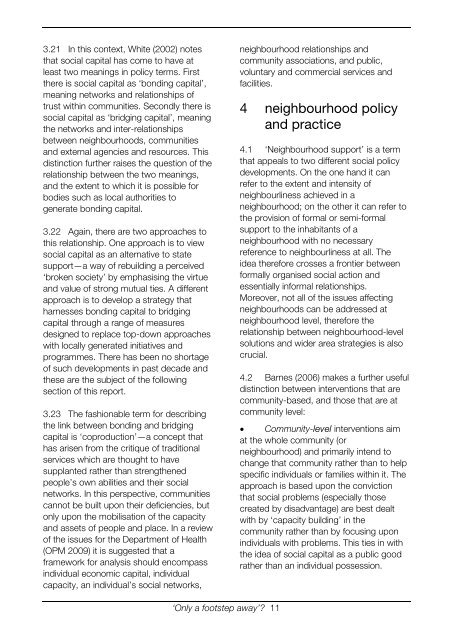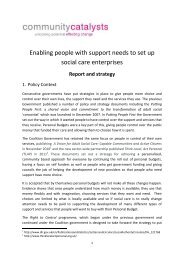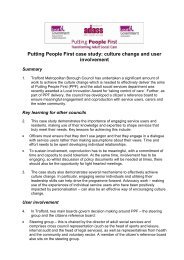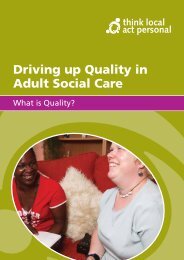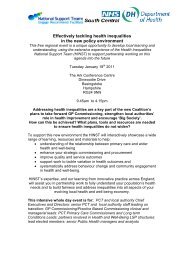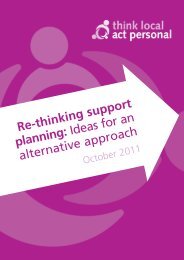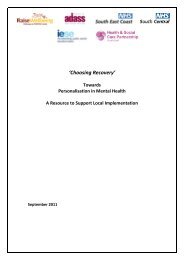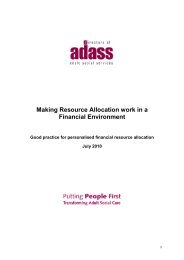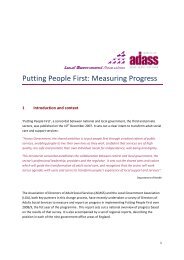'Only a footstep away' - Skills for Care - Think Local Act Personal
'Only a footstep away' - Skills for Care - Think Local Act Personal
'Only a footstep away' - Skills for Care - Think Local Act Personal
- No tags were found...
You also want an ePaper? Increase the reach of your titles
YUMPU automatically turns print PDFs into web optimized ePapers that Google loves.
3.21 In this context, White (2002) notesthat social capital has come to have atleast two meanings in policy terms. Firstthere is social capital as ‘bonding capital’,meaning networks and relationships oftrust within communities. Secondly there issocial capital as ‘bridging capital’, meaningthe networks and inter-relationshipsbetween neighbourhoods, communitiesand external agencies and resources. Thisdistinction further raises the question of therelationship between the two meanings,and the extent to which it is possible <strong>for</strong>bodies such as local authorities togenerate bonding capital.3.22 Again, there are two approaches tothis relationship. One approach is to viewsocial capital as an alternative to statesupport—a way of rebuilding a perceived‘broken society’ by emphasising the virtueand value of strong mutual ties. A differentapproach is to develop a strategy thatharnesses bonding capital to bridgingcapital through a range of measuresdesigned to replace top-down approacheswith locally generated initiatives andprogrammes. There has been no shortageof such developments in past decade andthese are the subject of the followingsection of this report.3.23 The fashionable term <strong>for</strong> describingthe link between bonding and bridgingcapital is ‘coproduction’—a concept thathas arisen from the critique of traditionalservices which are thought to havesupplanted rather than strengthenedpeople’s own abilities and their socialnetworks. In this perspective, communitiescannot be built upon their deficiencies, butonly upon the mobilisation of the capacityand assets of people and place. In a reviewof the issues <strong>for</strong> the Department of Health(OPM 2009) it is suggested that aframework <strong>for</strong> analysis should encompassindividual economic capital, individualcapacity, an individual’s social networks,neighbourhood relationships andcommunity associations, and public,voluntary and commercial services andfacilities.4 neighbourhood policyand practice4.1 ‘Neighbourhood support’ is a termthat appeals to two different social policydevelopments. On the one hand it canrefer to the extent and intensity ofneighbourliness achieved in aneighbourhood; on the other it can refer tothe provision of <strong>for</strong>mal or semi-<strong>for</strong>malsupport to the inhabitants of aneighbourhood with no necessaryreference to neighbourliness at all. Theidea there<strong>for</strong>e crosses a frontier between<strong>for</strong>mally organised social action andessentially in<strong>for</strong>mal relationships.Moreover, not all of the issues affectingneighbourhoods can be addressed atneighbourhood level, there<strong>for</strong>e therelationship between neighbourhood-levelsolutions and wider area strategies is alsocrucial.4.2 Barnes (2006) makes a further usefuldistinction between interventions that arecommunity-based, and those that are atcommunity level:• Community-level interventions aimat the whole community (orneighbourhood) and primarily intend tochange that community rather than to helpspecific individuals or families within it. Theapproach is based upon the convictionthat social problems (especially thosecreated by disadvantage) are best dealtwith by ‘capacity building’ in thecommunity rather than by focusing uponindividuals with problems. This ties in withthe idea of social capital as a public goodrather than an individual possession.‘Only a <strong>footstep</strong> away’? 11


